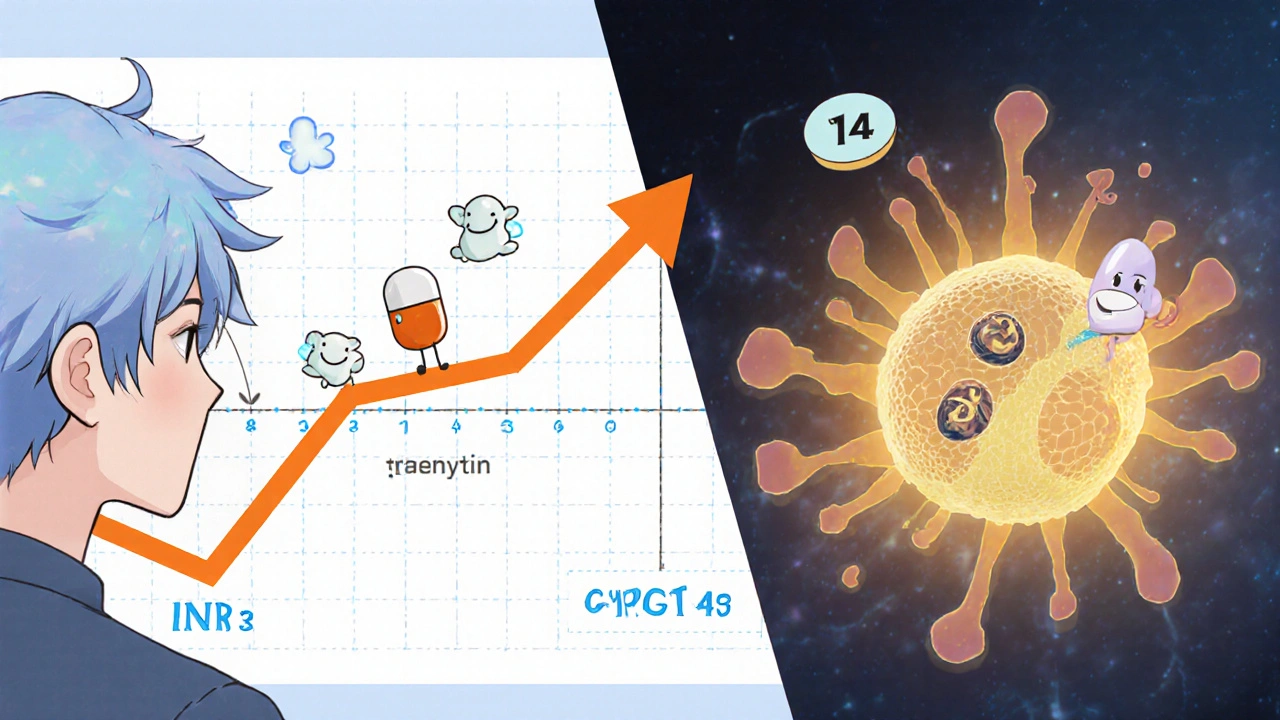Phenytoin-Warfarin Interaction Tracker
Current Status
INR Timeline
Recommendations
Enter your values to get personalized recommendations.
When you prescribe a seizure drug and a blood thinner to the same patient, you’re walking a tightrope. The combo of Phenytoin is a classic antiepileptic with high protein binding and enzyme‑inducing properties and Warfarin is a vitamin‑K antagonist used for long‑term anticoagulation creates a notorious biphasic interaction that can swing the International Normalized Ratio (INR) up, then down, often within the same treatment course. If you grasp the two underlying mechanisms-protein‑binding displacement and CYP450 induction-you can keep patients safe without endless dose guessing.
Why This Interaction Is a Headache
Warfarin is >99% bound to albumin. The tiny free fraction drives its anticoagulant effect and is what the INR measures. Phenytoin, also 90‑95% albumin‑bound, has a higher affinity for the same binding sites. When you start phenytoin, it nudges warfarin off albumin, suddenly boosting free warfarin by 20‑30% in just 48 hours. The INR spikes, bleeding risk jumps, and clinicians often panic.
But the story doesn’t end there. Within a week, phenytoin turns on the liver’s CYP2C9 and CYP3A4 enzymes via the pregnane X receptor (PXR). Those enzymes crank up clearance of the more potent S‑warfarin enantiomer, forcing you to raise the warfarin dose 2‑to‑5‑fold to keep the INR in range. Miss the induction phase, and the INR will drift low, risking clot formation.
Phase 1: Protein‑Binding Displacement (Day 0‑3)
- Occurs within 24‑72 hours of phenytoin initiation.
- Free warfarin fraction rises by ~0.02-0.03 of total dose.
- Patients with hypoalbuminemia (<3.5 g/dL) see an even bigger swing.
- INR can shoot up by 0.5‑1.5 units, occasionally >3.0.
Key point: Do NOT immediately increase the warfarin dose. Hold steady, re‑check INR every 2‑3 days, and be ready to reduce warfarin if the INR climbs too high.
Phase 2: Enzyme Induction (Day 7‑14)
- Phenytoin induces CYP2C9 by up to 400% and CYP3A4 by up to 300%.
- S‑warfarin clearance rises 50‑100%.
- Warfarin dose often needs 2‑5× increase to maintain target INR (2.0‑3.0 for most indications).
- Genetic variants (CYP2C9*2, *3) magnify the dose jump.
During this window, monitor INR twice weekly until it stabilises, then switch to weekly checks. Adjust warfarin based on the trend-not a single outlier.

Clinical Impact: How the INR Curve Looks
| Day | Dominant Mechanism | INR Trend | Action |
|---|---|---|---|
| 0‑3 | Protein‑binding displacement | ↑ (often >0.5 units) | Hold warfarin dose; consider temporary reduction if INR >4 |
| 4‑7 | Transition phase | ↓ toward baseline | Re‑evaluate; no dose change unless INR <2.0 |
| 8‑14 | Enzyme induction | ↓ below therapeutic range | Increase warfarin dose (often 2‑5×) |
| >14 | Steady state | Variable, depends on genetics & albumin | Fine‑tune dose; maintain weekly INR checks |
Genetic Factors That Tilt the Balance
Pharmacogenetics isn’t just hype-CYP2C9 and VKORC1 genotypes can shift how much warfarin you need after induction. Poor metabolizers (CYP2C9*3/*3) may see a dose increase >5‑fold, while normal metabolizers follow the 2‑5× rule. If your clinic offers rapid genotyping, use the results to set an initial warfarin dose after phenytoin starts, then let the INR guide final tweaks.
Managing the Interaction: Practical Checklist
- Baseline assessment: Record current warfarin dose, INR trend, serum albumin, liver function, and any CYP2C9/VKORC1 genotype if available.
- Start phenytoin: Use the lowest effective dose; avoid loading bolus if possible.
- INR monitoring: Check every 2‑3 days for the first week, then twice weekly until day 14, then weekly.
- If INR >4, hold warfarin and repeat INR in 24 h.
- If INR <2 after day 7, begin incremental warfarin increase (10‑15% per step).
- Dose adjustment algorithm (simplified):
- Day 0‑3: No change unless INR >4 → reduce warfarin 10‑20%.
- Day 8‑14: Increase warfarin by 25‑50% each 3‑day interval until INR ≥2.
- When stopping phenytoin: Anticipate a gradual rise in INR over 10‑14 days; pre‑emptively reduce warfarin by 25‑50% and monitor closely.
- Consider alternatives: If the patient’s anticoagulation is critical and frequent monitoring isn’t feasible, switch to a non‑enzyme‑inducing antiepileptic (levetiracetam, gabapentin, pregabalin) or a DOAC that isn’t contraindicated (e.g., apixaban for some mechanical valves is still off‑label).
Alternative Antiepileptics with Minimal Warfarin Interaction
Levetiracetam, gabapentin, and pregabalin all have low protein binding and are not CYP inducers. They let you keep the original warfarin dose and avoid the biphasic swing entirely. In patients with stable anticoagulation, many specialists now make the switch before phenytoin is ever started.
Future Directions: Genetics and Point‑of‑Care Testing
Point‑of‑care INR meters are now standard in many outpatient clinics, making twice‑daily checks practical for high‑risk patients. Meanwhile, rapid pharmacogenetic panels are becoming cheaper, allowing you to predict the magnitude of warfarin dose changes before phenytoin even hits the bloodstream. The next iteration of the FDA’s warfarin dosing algorithm may integrate real‑time enzyme induction data, turning this reactive process into a proactive one.
Quick Reference Cheat Sheet
- First 3 days: Expect INR rise → hold warfarin if >4.
- Day 4‑7: Watch for drop back to baseline.
- Day 8‑14: Prepare to boost warfarin 2‑5×.
- After day 14: Stabilise dose; continue weekly INR checks.
- If phenytoin stops: Reduce warfarin 25‑50% and monitor for 10‑14 days.
Why does the INR spike right after starting phenytoin?
Phenytoin displaces warfarin from albumin, increasing the free, active fraction of warfarin. The INR reflects that sudden boost in anticoagulant activity.
When should I increase the warfarin dose?
Typically after day 8‑10, when phenytoin’s enzyme‑inducing effect is fully active and the INR falls below the therapeutic range. Increase in small steps (10‑15% every 3 days) until the INR stabilises.
Can genetic testing help?
Yes. CYP2C9 and VKORC1 variants predict how much warfarin dose will need to change. Poor metabolizers may require larger dose hikes after induction.
What if the patient is on a DOAC?
Phenytoin reduces DOAC levels by inducing CYP3A4 and P‑glycoprotein, so most clinicians avoid that combo unless the DOAC is dose‑adjusted and closely monitored.
Is there a simple way to stop the interaction?
Switching the antiepileptic to levetiracetam, gabapentin, or pregabalin eliminates both protein displacement and enzyme induction, letting you keep the original warfarin regimen.

Jennie Smith
October 25, 2025 AT 19:25Wow, this post really pulls together the nitty‑gritty of the phenytoin‑warfarin dance. I love how you broke down the two phases – makes it way easier to remember when to hold warfarin and when to crank it up. The checklist is a lifesaver for busy clinics. Definitely gonna pin this on my desk and share with the resident team. Thanks for the colorful walkthrough!
Donal Hinely
November 4, 2025 AT 21:27Listen, the enzyme induction part is the real beast. By day 8‑10 you’re looking at a 400% jump in CYP2C9 activity, so the warfarin dose can explode 2‑5× if you’re not on top of those INR checks. It’s not just a “slight” tweak – it’s a full‑blown dose overhaul. Keep an eye on those labs twice a week and you’ll dodge the clot‑bleed rollercoaster.
christine badilla
November 14, 2025 AT 23:29Oh my gosh, let me tell you, this whole phenytoin‑warfarin saga is like a soap opera in my bloodstream! First, you pop that seizure med and bam – the free warfarin skyrockets like fireworks on the Fourth of July, and I’m sitting there watching the INR climb like a climbing vine with no brakes. I can already hear the nurses yelling, “Hold the warfarin!” and my heart doing a little cartwheel. Then, just when you think the drama is over, week two rolls around and phenytoin flips the switch on the liver’s CYP enzymes, turning my metabolism into a turbo‑charged race car. Suddenly, the S‑warfarin is being cleared faster than a gossip rumor at a high‑school reunion, and the INR crashes down like a house of cards in a hurricane. I’m frantically adjusting doses, feeling like a DJ at a rave, turning the volume up and down, hoping to find that sweet spot. The genetic polymorphisms add another twist – it’s like discovering a secret tunnel in a haunted mansion, and if you’re a poor metabolizer, the dose jump is even wilder, a 5‑fold increase that could make your head spin. All the while, you’re juggling albumin levels, watching labs every other day, and praying the patient doesn’t bleed or clot. It’s a high‑stakes juggling act, a tightrope walk with no safety net. And just when you think you’ve mastered the routine, you have to reverse it if phenytoin stops – the INR climbs back up like a tide that refuses to ebb. The whole thing feels like an endless loop of suspense, thriller, and tragedy, all wrapped up in a tiny pill. If you’re not prepared, it’s a recipe for disaster, a roller‑coaster that might leave you screaming for the brakes. So, strap in, keep those INR reads coming, and remember: this isn’t just pharmacology, it’s a dramatic performance starring your patient’s blood.
Octavia Clahar
November 25, 2025 AT 01:31That was an epic recount, but let’s keep it clinical. The key is proactive monitoring – you can’t afford to wait for a dramatic INR spike. Use the genotype data if you have it, it sharpens the dose‑adjustment curve.
Justin Scherer
December 5, 2025 AT 03:34Hold warfarin for the first three days if INR climbs.